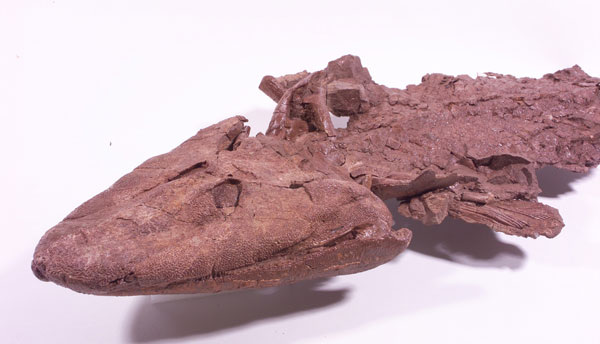
© Ted Daeschler, Academy of Natural SciencesThe head skeleton of Tiktaalik.
In a new study of a fossil fish that lived 375 million years ago, scientists are finding striking evidence of the intermediate steps by which some marine vertebrates evolved into animals that walked on land.
There was much more to the complex transition than fins morphing into sturdy limbs. The head and braincase were changing, a mobile neck was emerging and a bone associated with underwater feeding and gill respiration was diminishing in size - a beginning of the bone's adaptation for an eventual role in hearing for land animals.
The anatomy of this early transformation in life from water to land had never been observed with such clarity, paleontologists and biologists said in announcing the research on Wednesday.
The scientists said in a
report being published Thursday in the journal
Nature that the research exposed delicate details of the creature's head and neck, confirming and elaborating on its evolutionary position as "an important stage in the origin of terrestrial vertebrates."
In that case, the fish, a predator up to nine feet long, was a predecessor of amphibians, reptiles and dinosaurs, mammals and eventually humans. The fossil species was named Tiktaalik roseae, nicknamed "fishapod" for its fishlike features combined with limbs similar to tetrapods, four-legged land animals.
The new research on the head skeleton of Tiktaalik (pronounced tic-TAH-lick) was conducted at the Academy of Natural Sciences in Philadelphia and the University of Chicago.
"The braincase, palate and gill arch skeleton of Tiktaalik have been revealed in great detail," said Jason Downs, a research fellow at the academy and lead author of the report. "By revealing new details of the pattern of change in this part of the skeleton, we see that cranial features once associated with land-living animals were first adaptations for life in shallow water."
Several skeletons of the fish were excavated four years ago on Ellesmere Island, in the Nunavut Territory of Canada, 700 miles above the Arctic Circle, by a team led by Neil H. Shubin, an evolutionary biologist at the University of Chicago and the Field Museum, and Ted Daeschler of the Academy of Natural Sciences. The Devonian-age rocks containing the fossils indicated that the fishapod lived in shallow waters of a warm climate. It may have made brief forays on land.
Since the discovery was reported in 2006, Dr. Downs and two specimen preparators, C. Frederick Mullison of the academy and Bob Masek at Chicago, spent more than a year prying deeply into the skulls of several fishapod skeletons. The results were also analyzed by Dr. Shubin and two other co-authors of the report, Dr. Daeschler of the academy and Farish Jenkins Jr., an evolutionary biologist at Harvard.
"Our work demonstrates that the head of these animals was becoming more solidly constructed and, at the same time, more mobile with respect to the body across this transition," Dr. Daeschler said.
Dr. Shubin said that Tiktaalik was "still on the fish end of things, but it neatly fills a morphological gap and helps to resolve the relative timing of this complex transition."
For example, fish have no neck but "we see a mobile neck developing for the first time in Tiktaalik," Dr. Shubin said.
"When feeding, fish orient themselves by swimming, which is fine in deep water, but not for an animal whose body is relatively fixed, as on the bottom of shallow water or on land," he added. "Then a flexible neck is important."
One of the most intriguing findings, scientists said, was the reduction in size of a bony element that, in fish, links the braincase, palate and gills and is associated with underwater feeding and respiration. In more primitive fish, the bony part of what is called the hyomandibula is large and shaped like a boomerang. In this fossil species, the bone was greatly reduced, no bigger than a human thumb.
"This could indicate that these animals, in shallow-water settings, were already beginning to rely less on gill respiration," Dr. Downs said, noting the specimen's loss of rigid gill-covering bones, which apparently allowed for increased neck mobility.
In the transition from water to land, the researchers said, the hyomandibula gradually lost its original functions and, in time, gained a role in hearing. In humans, as in other mammals, the hyomandibula, or stapes, is one of the tiny bones in the middle ear.
As Dr. Daeschler said, "The new study reminds us that the gradual transition from aquatic to terrestrial lifestyles required much more than the evolution of limbs."
Reader Comments
to our Newsletter